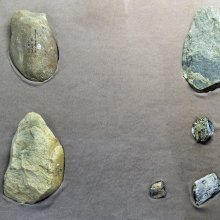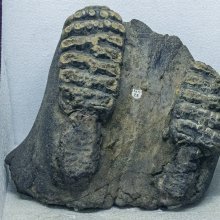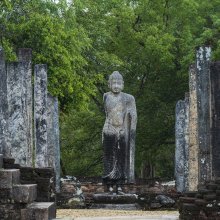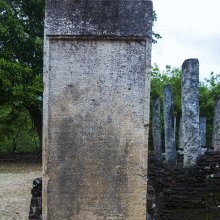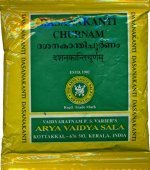Tooth, Teeth: 4 definitions
Introduction:
Tooth means something in Hinduism, Sanskrit, biology. If you want to know the exact meaning, history, etymology or English translation of this term then check out the descriptions on this page. Add your comment or reference to a book if you want to contribute to this summary article.
Images (photo gallery)
(+47 more images available)
In Hinduism
Purana and Itihasa (epic history)
Source: Shodhganga: Elements of Art and Architecture in the Trtiyakhanda of the VisnudharmottarapuranaTeeth (and other body parts) were traditionally coloured by professional artists, as part of the “sixty four kinds of Art”, according to the Kamasutra of Vatsyayana.—Cf. the Sanskrit Daśanavasanāṅgarāga.—Indian tradition, basically includes sixty four Art forms are acknowledged. The history of Indian Art covers approximately five thousand years which presents a rich and almost continuous record. The references of sixty four kinds of Kala (कला, kalā) are found in the Bhagavatapurana, Shaiva-Tantras, Kamasutra of Vatsyayana etc.

The Purana (पुराण, purāṇas) refers to Sanskrit literature preserving ancient India’s vast cultural history, including historical legends, religious ceremonies, various arts and sciences. The eighteen mahapuranas total over 400,000 shlokas (metrical couplets) and date to at least several centuries BCE.
Gitashastra (science of music)
Source: Shodhganga: Elements of Art and Architecture in the Trtiyakhanda of the Visnudharmottarapurana (gita)The Teeth (in Sanskrit: Danta) refers to one of various Organs of Utterance (sthāna), according to Bhattojidīkṣita in his Siddhāntakaumudī.—During the practise of Vocal Music, the proper production of the concerned sound is always considered as very important. Sthāna or ucchāraṇasthāna is the place of articulation of sound. Bhattojidīkṣita in his Siddhāntakaumudī said about ten kinds of sthāna (i.e., the organs of utterance), e.g., danta (teeth).
Gitashastra (गीतशास्त्र, gītaśāstra) refers to the ancient Indian science of Music (gita or samgita), which is traditionally divided in Vocal music, Instrumental music and Dance (under the jurisdiction of music). The different elements and technical terms are explained in a wide range of (often Sanskrit) literature.
Shilpashastra (iconography)
Source: Shodhganga: Elements of Art and Architecture in the Trtiyakhanda of the Visnudharmottarapurana (shilpa)The Teeth are denoted by the Sanskrit term Danta, and represents one of the various body parts whose Measurements should follow the principles of ancient Indian Painting (citra), according to the Viṣṇudharmottarapurāṇa, an ancient Sanskrit text which (being encyclopedic in nature) deals with a variety of cultural topics such as arts, architecture, music, grammar and astronomy.—In the third part of the Viṣṇudharmottarapurāṇa, chapters 35th to 43rd are dedicated to the Painting of different portraits of different kinds of men and women. The measurement of almost all the body parts that should be maintained in a picture have been presented here. For example, the Teeth (danta) should be 12 aṅgulas.

Shilpashastra (शिल्पशास्त्र, śilpaśāstra) represents the ancient Indian science (shastra) of creative arts (shilpa) such as sculpture, iconography and painting. Closely related to Vastushastra (architecture), they often share the same literature.
Biology (plants and animals)
Source: Google Books: CRC World Dictionary (Regional names)1) Tooth in India is the name of a plant defined with Morus alba in various botanical sources. This page contains potential references in Ayurveda, modern medicine, and other folk traditions or local practices It has the synonym Morus australis Poir. (among others).
2) Tooth is also identified with Morus australis It has the synonym Morus bombycis var. tiliifolia Koidz. (etc.).
Example references for further research on medicinal uses or toxicity (see latin names for full list):
· Botanical Magazine, or ‘Flower-Garden Displayed’ (Tokyo) (1915)
· Acta Biologica Cracoviensia, Series Botanica (1989)
· Botanical Magazine, or ‘Flower-Garden Displayed’ (Tokyo) (1917)
· Descr. Mûriers (1855)
· Notulae ad Plantas Asiaticas (1854)
· Flora de la región del Parque Nacional Amboró Bolivia (2004)
If you are looking for specific details regarding Tooth, for example pregnancy safety, chemical composition, side effects, extract dosage, diet and recipes, health benefits, have a look at these references.

This sections includes definitions from the five kingdoms of living things: Animals, Plants, Fungi, Protists and Monera. It will include both the official binomial nomenclature (scientific names usually in Latin) as well as regional spellings and variants.
See also (Relevant definitions)
Starts with: Boar tooth, Monkey tooth, Tooth cup, Tooth-brush bush, Tooth-pick, Toothache berry, Toothache plant, Toothache tree, Toothbrush tree, Toothed bur clover, Toothed burclover, Toothed maidenplum, Toothed medic, Toothed medick, Toothed spurge, Toothed-leaved pelargonium, Tootho, Toothpick ammi.
Ends with: Boar tooth, Dog tooth, Monkey tooth, Pick-tooth.
Full-text (+2048): Danta, Dasana, Dantakashtha, Dantadhavana, Radana, Damshtra, Dantura, Dadaka, Dantaka, Adhidanta, Rada, Dadha, Rajadanta, Isadanta, Shyavadanta, Dantaharsha, Dantamula, Jambha, Manjana, Dantasharkara.
Relevant text
Search found 322 books and stories containing Tooth, Teeth; (plurals include: Tooths, Teeths). You can also click to the full overview containing English textual excerpts. Below are direct links for the most relevant articles:
Vinaya (3): The Cullavagga (by T. W. Rhys Davids)
Cullavagga, Khandaka 5, Chapter 31 < [Khandaka 5 - On the Daily Life of the Bhikkhus]
Cullavagga, Khandaka 5, Chapter 1 < [Khandaka 5 - On the Daily Life of the Bhikkhus]
Cullavagga, Khandaka 5, Chapter 9 < [Khandaka 5 - On the Daily Life of the Bhikkhus]
Cosmetics, Costumes and Ornaments in Ancient India (by Remadevi. O.)
2.8. Pharmaceutical use of Tooth Sticks < [Chapter 1 - Cosmetics]
9. Prohibition of Cosmetics < [Chapter 1 - Cosmetics]
7. Cosmetics According to Different Regions < [Chapter 1 - Cosmetics]
Sushruta Samhita, volume 4: Cikitsasthana (by Kaviraj Kunja Lal Bhishagratna)
Chapter XXII - The affections of the mouth
Chapter XXIV - The rules of hygiene and general conduct
Chapter XL - Description of medicated fumes, snuffs, errhines and gargles
Charaka Samhita and Sushruta Samhita (by Nayana Sharma)
Personal Hygiene < [Chapter 6]
List of Surgical Conditions in the Suśruta Saṃhitā < [Chapter 9]
Quackery: The “Fraudulent” Medical Practitioners < [Chapter 2]
Brihat Samhita (by N. Chidambaram Iyer)
Chapter 85 - On Tooth-brush (dantakāṣṭha-lakṣaṇa)
Chapter 66 - On the features of the Horse (aśva-lakṣaṇa)
Vinaya Pitaka (1): Bhikkhu-vibhanga (the analysis of Monks’ rules) (by I. B. Horner)
Related products
(+12 more products available)
